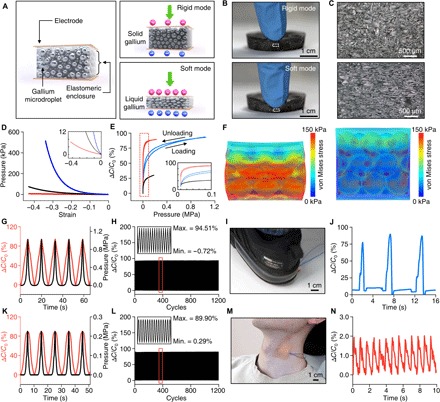Fig. 4. Application demonstration of transformative electronics for pressure sensing, tuning both the sensitivity and dynamic range for versatile operation.

(A) Conceptual illustration of a tunable pressure sensor based on an elastomeric composite with gallium-microdroplet inclusion. In the rigid mode, the microporous dielectric elastomer filled with solid gallium undergoes small compressive deformation due to its high effective modulus leading to large dynamic range for pressure sensing. In the soft mode, the microporous elastomer with liquefied gallium becomes much more compliant, resulting in higher sensitivity and lower dynamic range. (B) Photographs of a gallium-elastomer composite in the rigid (top) and soft (bottom) states under compression by a fingertip. (C) Cross-sectional optical micrographs of the gallium-elastomer composite in the rigid (top) and soft (bottom) states under compression, corresponding to the dotted rectangular areas in (B). (D) Pressure versus strain curves of the composite in the soft (red) and rigid modes (blue) in comparison to that of a pure elastomer (black). The inset shows magnified plots for the pressure range between 0 and 12 kPa. (E) Relative capacitance changes of the tunable pressure sensor with applied pressure in the rigid and soft modes. Red, blue, and black lines are plots for the composite in the soft and rigid modes and the pure elastomer, respectively. (F) FEA simulation results demonstrating the stress distribution in the composite in the soft (left) and rigid modes (right) under a compressive pressure of 50 kPa. The diameter of the gallium microdroplets is assumed to be 125 ± 50 μm (mean ± SD) based on our measurements (fig. S7E). (G and K) Cyclic capacitive response of a sensor (red) to applied pressure [1 MPa for the rigid mode (G) and 0.22 MPa for the soft mode (K); black] as a function of time in the rigid (G) and soft modes (K). The speed of loading and unloading was 0.167 mm/s in (G) and (K). (H and L) Loading and unloading test in the rigid (H) and soft (L) modes for 1200 cycles. (I and J) Image (I) and measurement result (J) demonstrating the application of a pressure sensor in the rigid mode for foot stepping pressure sensing. (M and N) Image (M) and measurement result (N) demonstrating the application of a pressure sensor in the soft mode for monitoring of carotid arterial blood pressure. Photo credit: Sang-Hyuk Byun.
